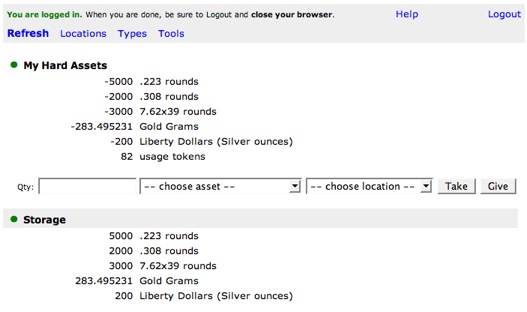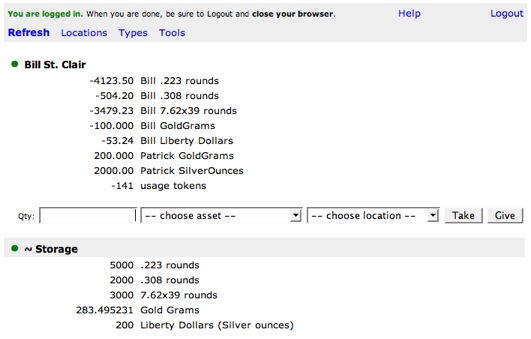Patrick's Loom Issuance Scheme
In a comment Creating Your Own Loom Currency article, I mentioned that Patrick Chkoreff uses a different mechanism than I proposed to make sure he doesn't issue more digital currency than he has real assets for backing. Here I elucidate that a little.
I'm going to imagine that I have in my basement some gold, some Liberty Dollars, and three calibers of ammunition. I set up a Loom folder to track those real assets, moving the amount I have of each into the "Storage" location in Loom.

In my regular Loom account, I have a digital currency corresponding to each:
| Real Asset | Digital Currency |
| .223 rounds | Bill .223 rounds |
| .308 rounds | Bill .308 rounds |
| 7.62x39 rounds | Bill 7.62x39 rounds |
| Gold Grams | Bill GoldGrams |
| Liberty Dollars (Silver ounces) | Bill Liberty Dollars |
I import the real asset "Storage" location into my regular account, but prepend the name with a "~" to mark it as a private location that I never use for trade.
I also imagine that I have received Patrick's digital gold and silver in payment. So my home folder now looks like this:

Now I just have to make sure I don't allow the negative number in front of each digital currency in my folder to exceed the corresponding amount in storage. Ooops. I'm doing fractional reserve banking in 7.62x39 rounds. Better buy some ammo or some currency.
This way of tracking issuance is especially nice when you issue more than one digital currency. It takes up minimal space on the issuance page. I could see having three folders, one for hard assets, one for issuance, and one for personal use.
Another Loom issuer/reserve idea
I had another idea for this. Keep the issuance for the circulating asset types and their corresponding private reserve types in one folder, the "reserve folder". Each time you get some more of the reserve commodity, issue a corresponding amount of that reserve type to the storage location and of the circulating type to a location you share with your personal folder. Then take the circulating asset into your personal folder. Your personal folder will simply have the circulating asset to spend. There's nothing to compare. All the comparisons are done in the reserve account, where the numbers always match exactly.
Similarly, when you want to sell some of the reserve commodity, give that amount of the circulating asset type from your personal folder to the shared location, and take it into the reserve folder. Then take the reserve asset type from the storage location and ship the commodity.
I'll work up screen shots of this soon.
Reserve Tracking
Right. Quite simply, I use two folders: one with only negative balances, and one with only positive balances. The folder with negative balances is for issuance, and the folder with positive balances is for normal operations.
You can easily extend and refine the scheme from there if you like. For example, I use a third folder for storing large positive balances I don't need to work with every day. That folder functions as a higher-security "vault" which I seldom enter.

Folder Hints
Great article Bill. I like what you say about having a separate folder just for issuance. That's what I do. My Issuance folder has only negative balances, and my Main day-to-day folder has only positive balances.
When I plop a new gold ounce into the reserve vault, I log into the Issuance folder and "Give" 31.1034768 new gold grams to my internal drop point "~tmp". Then I log into my Main folder and see the 31.1034768 grams at that drop point, and I Take them into my main stash there.
If those gold grams are in fact my property, then I'm done. But if the gold belongs to someone else, say "Alice," then I must Give the 31.1034768 grams over to the Alice drop point so she can pick them up.
You don't have to use this two-step process, but I like it because it minimizes the amount of time I spend logged into my Issuance folder (a relatively dangerous operation from a security standpoint).
Edit comment